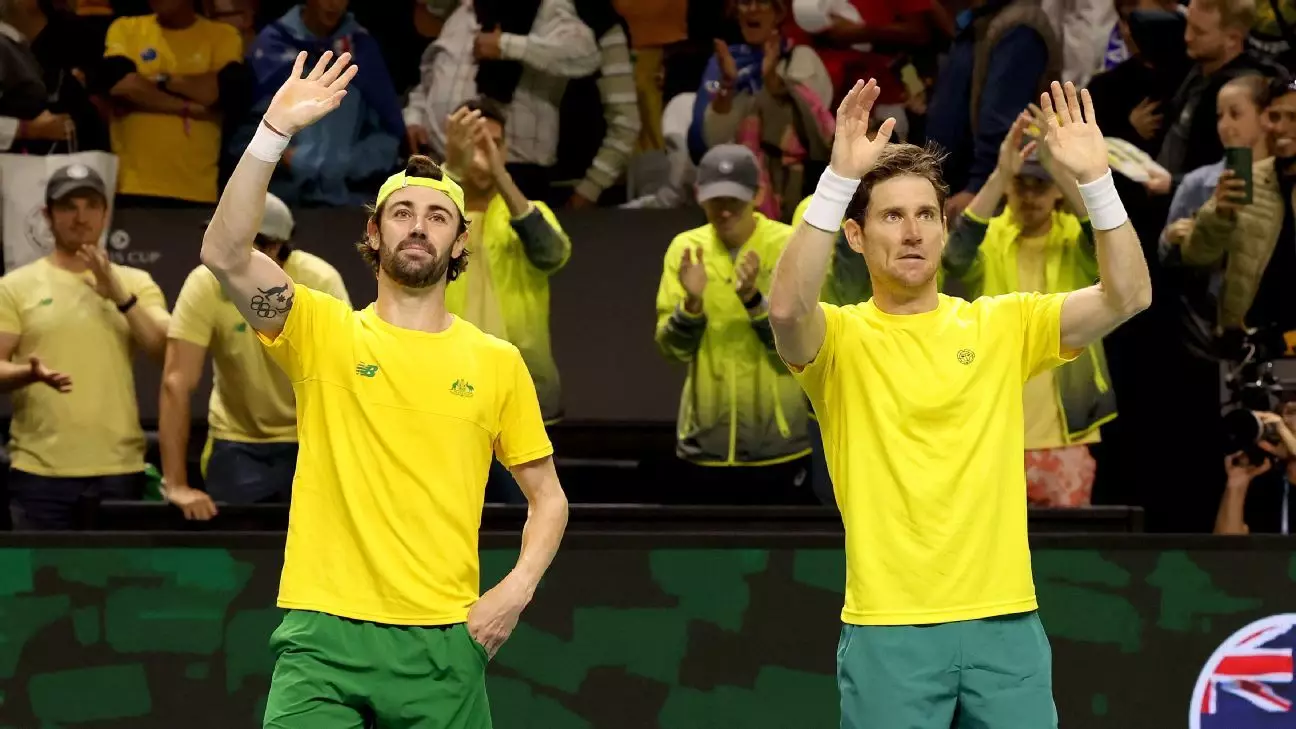The Davis Cup Dilemma: Analyzing Bob Bryan’s Bold Moves and Their Consequences
In the thrilling arena of international tennis, every decision a captain makes can tip the scales toward victory or defeat. Recently, the spotlight shone on U.S. Davis Cup captain Bob Bryan during a nail-biting quarterfinal match against Australia. With the series tied at one match apiece, Bryan faced a strategic crossroads. He gambled by fielding an untested doubles team—Tommy Paul and Ben Shelton—instead of the seasoned pair of Austin Krajicek and Rajeev Ram, who had claimed silver at the Paris Olympics. This bold move, however, didn’t pan out as hoped and ultimately underscored the ongoing challenges facing American tennis in this prestigious competition.
The gamble concluded with the American duo falling 6-4, 6-4 to Australia’s Matthew Ebden and Jordan Thompson. This defeat not only propelled Australia into the semifinals but also marked another year without a Davis Cup title for the U.S., extending their drought to 17 years. Despite holding the record for most championships, their last triumph was back in 2007—a year when Bryan himself was still competing as a player. This prolonged dry spell has cast a shadow over American tennis, highlighting challenges on the global stage that seem increasingly difficult to overcome.
While the lack of synergy between Paul and Shelton contributed to their loss, several other factors were at play. For instance, Shelton’s earlier singles match ended in a narrow defeat to Thanasi Kokkinakis of Australia. Even with Taylor Fritz’s valiant effort securing a win against Alex de Minaur, the American team couldn’t find their rhythm in doubles play. The struggle emphasized how intricate team dynamics can become when transitioning from singles to doubles matches.

Bryan’s decision-making process offers a fascinating glimpse into the complexities of managing a national team in tennis. His intent was to “catch the Aussies by surprise,” but Australian captain Lleyton Hewitt was unperturbed, having already observed Paul and Shelton during practice sessions. This development suggests that what Bryan perceived as an element of surprise may have been more transparent than anticipated.
Key Takeaways
- The decision to field an untested doubles team highlighted strategic risks in high-stakes matches.
- The loss underscored America’s continued struggle to reclaim Davis Cup glory since 2007.
- Balancing fresh talent with experienced players remains a critical challenge for team captains.
The Intricacies of Team Strategy
Despite Bryan’s extensive background and accolades within the sport, his decision reflects a potential overreliance on intuition rather than data-driven strategy. This raises important questions about prioritizing chemistry and experience in doubles teams versus bringing unpredictability with new faces. As tennis increasingly becomes data-centric, relying solely on intuition could lead to missteps in critical junctures like this one.
Although Bryan provided various justifications for his lineup change—including Ebden’s familiarity with Krajicek and Ram—the underlying issue may point to broader challenges within American men’s tennis. The limited experience of Paul and Shelton as a doubles team might have contributed significantly to their inability to perform under pressure. Moreover, Shelton’s exertions in singles earlier could have compounded difficulties during their doubles encounter.
The Complexity of Representing National Pride
Representing one’s country adds layers of complexity and pressure unique to prestigious events like the Davis Cup. Players who shine solo might find it challenging to adapt to doubles’ distinct demands for teamwork and coordination. The pressure can magnify even subtle weaknesses, making it critical for captains like Bryan to consider both individual strengths and collective dynamics when assembling teams.
The recent defeat serves as both a wake-up call and an opportunity for introspection within U.S. men’s tennis. It highlights not just strategic gaps but also emphasizes player development needs and possibly reevaluating team assembly tactics for crucial matches. While integrating emerging talent with seasoned veterans holds promise, success hinges on achieving the right balance between cohesion and innovation.

Final Thoughts
Bob Bryan’s decision was rooted in analysis mixed with a desire to inject unpredictability into his team’s strategy against Australia. However, this move illustrates sports’ inherent unpredictability—where even well-thought-out plans can go awry under competitive pressure. As America strives to reclaim its former Davis Cup glory, reflecting on tactics will be vital moving forward. Balancing team chemistry against exciting yet untested partnerships is crucial for future successes in this historic competition.
Davis Cup
Bob Bryan
Tennis strategy
Team dynamics
Sports management


Leave a Reply